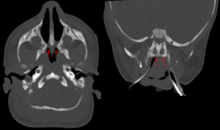Choanal atresia
| Classification according to ICD-10 | |
|---|---|
| Q30.0 | Choanal atresia |
| ICD-10 online (WHO version 2019) | |
As choanal (also atresia choanae ) is the innate membranous or bony closure of the posterior nasal opening designated. This closure is membranous in ten percent of those affected, and bony in 90 percent. The choans , as a pair of rear nostrils, form the transition from the nasal cavity to the pharynx . Atresia comes from the Greek ἄτρητος atretos , meaning "without opening". The incomplete closure is called choanal stenosis . There are the rarer anterior nasal atresia , located 1 to 2 cm from the nasal entrance . The middle atresia is mostly acquired as a result of chronic turbinate infections. The partial occlusion is called synechia.
distribution
Congenital choanal atresia is a rare malformation that occurs in 1 / 5,000 - 10,000 births. The one-sided choan closure is about five times more common than the bilateral one.
In some syndromes it can be an essential characteristic:
- Congenital subclavian steal sequence
- CHARGE syndrome
- Syndrome of the single maxillary central incisor (SMMCI syndrome)
Also at
- Antley-Bixler Syndrome
- Bosma syndrome , synonym: arrhinia-choanal atresia-microphthalmia; BOSMA Arhinia Microphthalmia Syndrome
- EEC syndrome
- Rodent syndrome
- Raine Syndrome
- Schinzel-Giedion syndrome
root cause
The choanas arise between the third and seventh embryonic weeks as an opening between the nasal cavity and the pharynx by tearing the membrana oro-nasalis , an epithelial duplication between the olfactory pit and the roof of the oral cavity. If a disturbance occurs during embryonic development at this point, the oronasal or bucconasal membrane does not tear at all or only incompletely, which results in incomplete (stenosis) or complete closure (atresia). The bony closure is created by a scattered bone formation from the middle cotyledon .
Symptoms
In bilateral choanal atresia, the newborn has a lack of nasal breathing and shortness of breath when drinking, so that food intake is severely impaired or impossible. The breathing disorder can lead to breathing stopping and threatening the life of the newborn. The newborn is cyanotic , has a slow heartbeat, and is vomiting. Since the cyanosis is less pronounced during exertion (screaming) than at rest (because of the mouth breathing), it is also referred to as paradoxical cyanosis . Due to a physiological elevated larynx, infants are nasal breathers until they are six weeks old and can only breathe through the mouth with difficulty.
A one-sided choana blockage often only becomes noticeable over time, and tough, purulent mucus emerges from the nostril on the affected side. The turbinates are livid in color.
Diagnosis
If choanal atresia is suspected, the patency of the pharynx can be checked with a soft catheter. Air injection with a balloon serves the same purpose. Further diagnostic steps are the examination with the nasal speculum and the nasal endoscopy . Depending on the need for clarification, a CT or an MRI should be used . Choanal atresia occur 10% to 50% with other malformations.
therapy
The bilateral choanal closure is an emergency. Light membranous occlusions can sometimes be pierced with the nasal catheter. Breathing must be secured through an endotracheal tube and nutrition must be ensured through a tube . The surgeon must be called in immediately. The perforation of the atresia plate with the insertion of a placeholder to avoid reclosure should take place in the first few days of life. The definitive operation can then be carried out within the first few weeks to months of life. There are two surgical access routes, one is through the nose and the other from the throat. After the operation, splints and measures to keep the airways clear by the parents are necessary. Long-term care is required because of the risk of swallowing disorders. In the case of one-sided choanal closure, the operation can be carried out in school children.
literature
- Helmut Patzer, Peter Großmann, Wolfgang Braun (eds.): Pediatrics. 2nd Edition. Verlag Volk und Gesundheit, Berlin 1981, p. 93.
- Wolfgang Plenert: Practical pediatric therapy . VEB Georg Thieme publishing house, Leipzig 1988, p. 20.
- Waldemar Ch. Hecker (Ed.): Elementary children's surgery. Urban & Schwarzenberg, Munich 1975, ISBN 3-541-07301-2 , pp. 138, 141.
- Rudolf Probst, Gerhard Grevers, Heinrich Iro: Ear, nose and throat medicine . Georg Thieme Verlag, Stuttgart 2000, ISBN 3-13-119031-0 , p. 28.
Web links
Individual evidence
- ↑ Bernfried Leiber (founder): The clinical syndromes. Syndromes, sequences and symptom complexes . Ed .: G. Burg, J. Kunze, D. Pongratz, PG Scheurlen, A. Schinzel, J. Spranger. 7., completely reworked. Edition. tape 2 : symptoms . Urban & Schwarzenberg, Munich et al. 1990, ISBN 3-541-01727-9 .
- ↑ Arrhinie - choanal - microphthalmia. In: Orphanet (Rare Disease Database).
